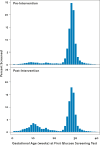Impact of earlier gestational diabetes screening for pregnant people with obesity on maternal and perinatal outcomes
- PMID: 35534914
- PMCID: PMC9519183
- DOI: 10.1515/jpm-2021-0581
Impact of earlier gestational diabetes screening for pregnant people with obesity on maternal and perinatal outcomes
Abstract
Objectives: Gestational diabetes (GDM) screening at 24-28 weeks' gestation reduces risk of adverse maternal and perinatal outcomes. While experts recommend first-trimester screening for high-risk patients, including those with obesity, data supporting this recommendation is limited.
Methods: We implemented a systematic population intervention to encourage first-trimester GDM screening by oral glucose tolerance testing in a cohort of pregnant people with obesity in two integrated health systems from 2009 to 2013, and compared outcomes to the same population pre-intervention (2006-2009). Up to five years of postpartum glucose testing results (through 2018) were assessed among GDM cases in the post-intervention group. Primary outcomes were large-for-gestational-age birthweight (LGA); macrosomia; a perinatal composite outcome; gestational hypertension/preeclampsia; cesarean delivery; and medication treatment of GDM.
Results: A total of 40,206 patients (9,156 with obesity) were screened for GDM; 2,672 (6.6%) were diagnosed with GDM. Overall, multivariate adjusted risk for LGA and cesarean delivery were lower following the intervention (LGA: aOR 0.89 [0.82, 0.96]; cesarean delivery: 0.89 [0.85, 0.93]). This difference was more pronounced in patients diagnosed with GDM (LGA: aOR 0.52 [0.39, 0.70]; cesarean delivery 0.78 [0.65, 0.94]); insulin/oral hypoglycemic treatment rates for GDM were also higher post-intervention than pre-intervention (22 vs. 29%; p<0.0001). There were no differences for the other primary outcomes. Only 20% of patients diagnosed with GDM early in pregnancy who had postpartum testing had results in the overt diabetes range, suggesting a spectrum of diabetes detected early in pregnancy.
Conclusions: First trimester GDM screening for pregnant people with obesity may improve GDM-associated outcomes.
Keywords: early gestational diabetes; early gestational diabetes screening; early pregnancy; gestational diabetes (GDM); intervention; obesity; timing of screening.
© 2022 Walter de Gruyter GmbH, Berlin/Boston.
Conflict of interest statement
Figures



Similar articles
-
Screening and diagnosing gestational diabetes mellitus.Evid Rep Technol Assess (Full Rep). 2012 Oct;(210):1-327. Evid Rep Technol Assess (Full Rep). 2012. PMID: 24423035 Free PMC article. Review.
-
Obstetric and perinatal outcomes of singleton pregnancies conceived via assisted reproductive technology complicated by gestational diabetes mellitus: a prospective cohort study.BMC Pregnancy Childbirth. 2018 Dec 14;18(1):495. doi: 10.1186/s12884-018-2115-4. BMC Pregnancy Childbirth. 2018. PMID: 30547777 Free PMC article.
-
Weight gain after diagnosis of gestational diabetes mellitus and its association with adverse pregnancy outcomes: a cohort study.BMC Pregnancy Childbirth. 2021 Mar 17;21(1):216. doi: 10.1186/s12884-021-03690-z. BMC Pregnancy Childbirth. 2021. PMID: 33731035 Free PMC article.
-
Fasting plasma glucose in the first trimester is related to gestational diabetes mellitus and adverse pregnancy outcomes.Endocrine. 2022 Jan;75(1):70-81. doi: 10.1007/s12020-021-02831-w. Epub 2021 Aug 3. Endocrine. 2022. PMID: 34342804 Free PMC article.
-
Are women positive for the One Step but negative for the Two Step screening tests for gestational diabetes at higher risk for adverse outcomes?Acta Obstet Gynecol Scand. 2018 Feb;97(2):122-134. doi: 10.1111/aogs.13254. Epub 2017 Dec 12. Acta Obstet Gynecol Scand. 2018. PMID: 29091257 Review.
Cited by
-
Progress in Research on Biomarkers of Gestational Diabetes Mellitus and Preeclampsia.Diabetes Metab Syndr Obes. 2023 Nov 22;16:3807-3815. doi: 10.2147/DMSO.S433179. eCollection 2023. Diabetes Metab Syndr Obes. 2023. PMID: 38028997 Free PMC article. Review.
-
Time to Move Beyond a Binary Criterion for Gestational Diabetes?Reprod Sci. 2024 Jul;31(7):2073-2079. doi: 10.1007/s43032-024-01514-x. Epub 2024 Mar 14. Reprod Sci. 2024. PMID: 38485893 Review.
-
Care provided to women during and after a pregnancy complicated by hyperglycaemia: the impacts of a multi-component health systems intervention.Lancet Reg Health West Pac. 2025 Mar 13;57:101514. doi: 10.1016/j.lanwpc.2025.101514. eCollection 2025 Apr. Lancet Reg Health West Pac. 2025. PMID: 40162037 Free PMC article.
-
Enhancing early gestational diabetes mellitus prediction with imputation-based machine learning framework: A comparative study on real-world clinical records.Digit Health. 2025 Jul 29;11:20552076251352436. doi: 10.1177/20552076251352436. eCollection 2025 Jan-Dec. Digit Health. 2025. PMID: 40755962 Free PMC article.
-
Advancement in predictive biomarkers for gestational diabetes mellitus diagnosis and related outcomes: a scoping review.BMJ Open. 2024 Dec 15;14(12):e089937. doi: 10.1136/bmjopen-2024-089937. BMJ Open. 2024. PMID: 39675825 Free PMC article.
References
-
- World Health Organization (WHO) Diagnostic criteria and classification of hyperglycaemia first detected in pregnancy. Geneva: World Health Organization (WHO); 2013. [7 Oct 2021]. https://apps.who.int/iris/bitstream/handle/10665/85975/WHO_NMH_MND_13.2_... Accessed. - PubMed
-
- Committee on Practice Bulletins—Obstetrics ACOG practice bulletin No. 190: gestational diabetes mellitus. Obstet Gynecol. 2018;131:e49–64. - PubMed
MeSH terms
Substances
Grants and funding
LinkOut - more resources
Full Text Sources
Medical
